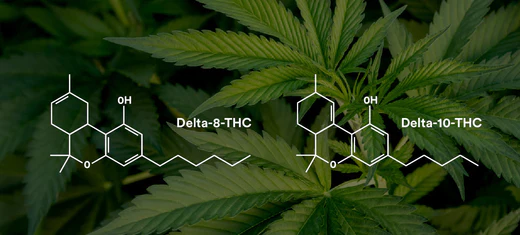October 3rd, 2022 | 6 min read
What is Delta-8 and Delta-10?
Delta-8 THC has had a rapid rise in popularity over the past year. If you consume cannabis, there’s a good chance you’ve heard of it.
Tetrahydrocannabinol (THC) has an ambiguous legal position that is complex and constantly evolving in the US. This evolution has inspired a new wave of entrepreneurs to innovate and bring new products to market. Among these new products is a cannabinoid called Delta-8. Delta 8 THC is extracted from hemp, while the traditional THC everyone knows and loves, Delta-9, is extracted from cannabis. Hemp is a term for cannabis that contains less than 0.3% THC.
Delta-8 and delta-10 are two cannabinoids in the cannabis plant that were discovered in 1965. Due to the 2018 Farm Bill legalizing the production of hemp in the U.S, these cannabinoids were legalized federally as they are derived from hemp. These cannabinoids are getting increasingly popular since they’re less potent thus easier for beginners to handle. Dankcave being one one of the best online smoke shops that sells delta products, we want to educate consumers on what it exactly is.
What is Delta 8?
The psychoactive substance called delta-8 THC is very similar to delta-9 THC, so similar that delta-8 is often called the younger sibling of delta-9. The main ingredient in the cannabis plant is delta-9 THC, an ingredient that is found in much lower quantities in the plant is delta-8. Despite delta-8 being comparable to delta-9 THC, the effects are minimized due to a difference of double bond position. This position difference results in delta 8 and 10 having a reduced reaction to the CB1 receptor of the endocannabinoid system. Users suggest Delta-8 induces effects similar to indica, however there is no studies verifying this.
What is Delta 10?
The delta-10 cannabinoid is in a similar vein as delta-8. They are both initially derived from a hemp-derived CBD and undergo chemical processing to reach their final state. Delta-10 in the cannabis plant is found in trace amounts and must be refined extensively, making the manufacturing of it a hassle. This is why you will often find many “delta–10” products combined with delta-8.
Delta-10 THC was discovered by mistake by a Californian company that had purchased some outdoor biomass to make concentrates. They were unaware that a recent blaze had left the plants tainted with a fire retardant. They evaluated their new concentrate and found it included an unusual crystal structure. A third-party lab’s more thorough investigation revealed that the fire-retardant chemicals had produced a novel type of THC.
Types of Delta 8 and 10 Products
Products made with delta 8 and delta 10 come in forms similar to how CBD and Delta-9 are consumed today such as:
– Edibles
– Vapes
– Flower
– Tincture Oils
– Topicals
– Beverages
– Capsules
What is Delta 9?
Delta-9 is the form of THC that everyone is familiar with, it’s what every dispensary in the world has been selling. This naturally occurring cannabinoid called delta-9-tetrahydrocannabinol is typically the main component of the cannabis plant. It is the tetrahydrocannabinol in marijuana with the highest potency.
Delta-9 THC is used recreationally and medically across the world. Its therapeutic potential and psychoactive effects have been extensively researched over numerous years. It has become wildly popular in countries such as the USA and Canada
Comparison of delta 8, delta 9 and delta 10
Many people compare these three THC forms by comparing how each affects the user. They are all cannabinoids in the cannabis plant, however the amount found and the location of where the double bond is located in the carbon ring is the real difference. This is what causes the huge difference in potency from delta-9 to delta-8 and delta-10. Anecdotal evidence at the moment suggests delta-8 to have sedating effects similar to indica while delta-10 is said to have energizing effects similar to sativa.
The origin of these THC variations is another significant distinction. Delta-8 and Delta-10 are naturally found in the cannabis plant but require laboratory synthesis before becoming a consumer product. This is because the cannabis plant naturally has low amounts delta-8 and delta-10.
What is the difference between Delta-8 and delta 10?
More is known of the similarities between these two isomers than the differences at the moment. The delta-10 cannabinoid is in a similar vein as delta-8. They are both initially derived from a hemp-derived CBD and undergo chemical processing to reach their final state. Both are also found in low amounts in the cannabis plant and have less potent versions of delta-9.
In terms of effects, there isn’t much research available at the moment that accurately differentiates the two. Anecdotal evidence from consumers suggests that Delta-10 produces effects similar to sativa while delta-9 produces effects similar to delta-10. It is also suggested by consumers that delta-10’s potency is less than that of delta-8, however there is no concrete evidence or reasoning for this.
Delta 8 and Delta 10: Are they legal?
Under the Agriculture Improvement Act (2018 Farm Bill), delta-8 and delta-10 are lawful on the U.S federal level as long as they are derived naturally from hemp. Individual state laws vary.
Conclusion: Why should you use Delta 8 or Delta 10?
Delta-8 and delta-10 are promisingly advantageous cannabinoids that are accessible in most of the US. If you’re a novice cannabis user looking for the advantages of THC without the strong psychoactive effects, its gentler effects are ideal.


